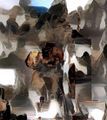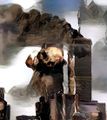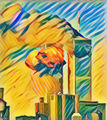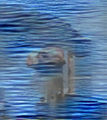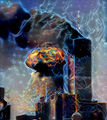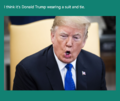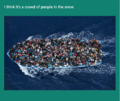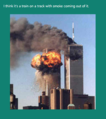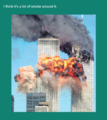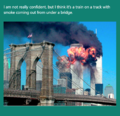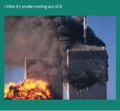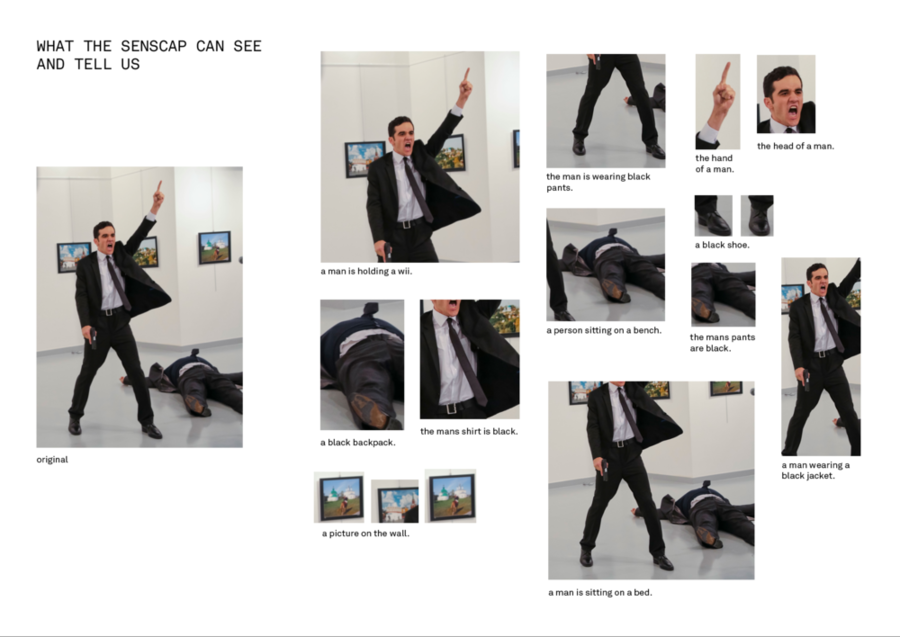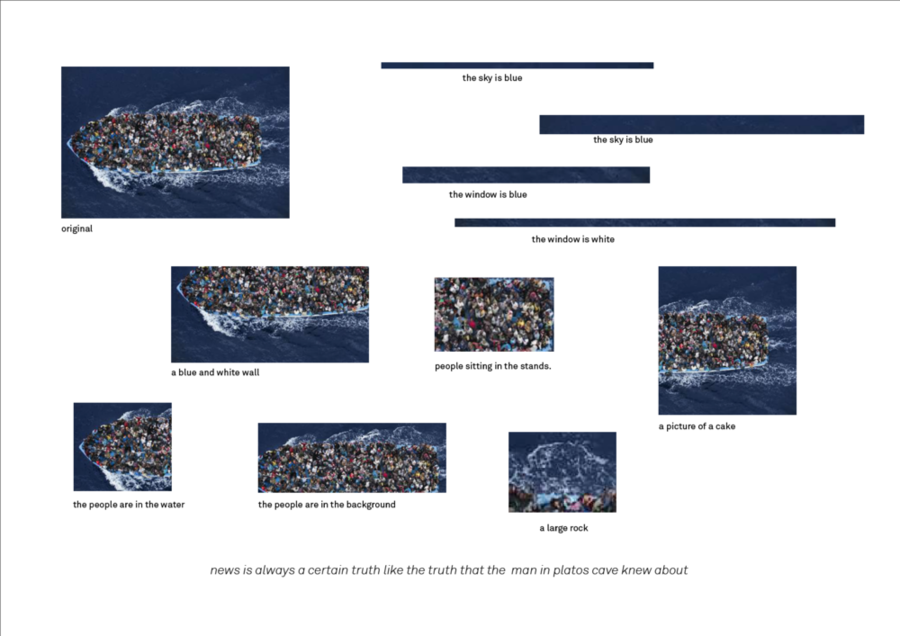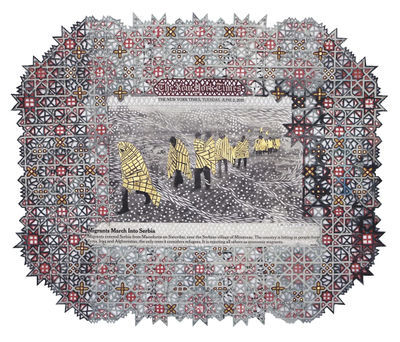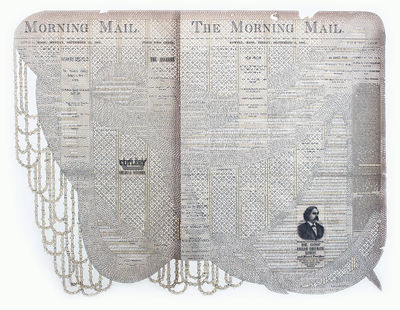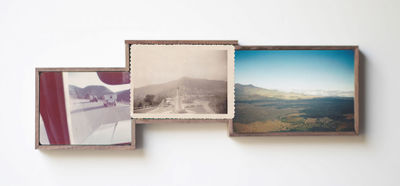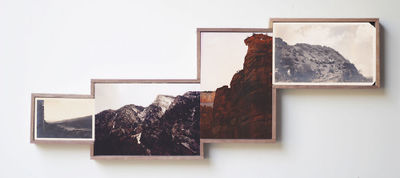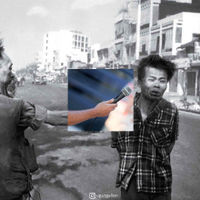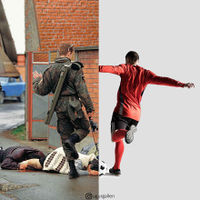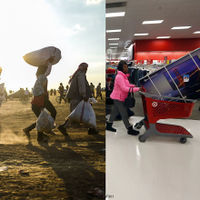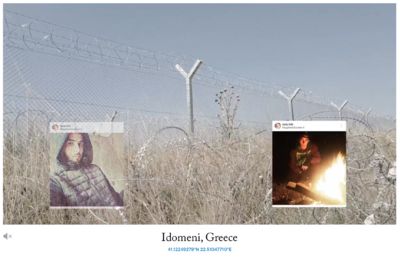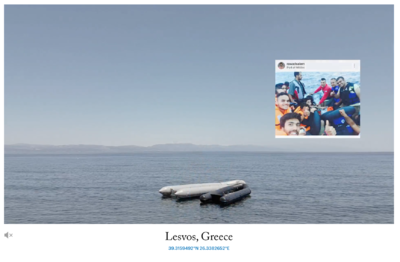Difference between revisions of "User:0911497/Graduation"
| Line 183: | Line 183: | ||
[http://www.bernkekleinzandvoort.com | BERNKE KLEIN ZANDVOORT - website ] | [http://www.bernkekleinzandvoort.com | BERNKE KLEIN ZANDVOORT - website ] | ||
| − | |||
Revision as of 19:04, 6 May 2019
Contents
INFO
Karlijn den Hoedt
0911497
Graphic design
projects I have worked on before
Digital Craft 2018: Cybernetics
QUESTION
- What does the representation within the news tell us about our society?
- How are certain groups of people represented within the news? (think about the refugee, the terrorist, etc)
- creates the news fear within our society? (Ruben paters - facts agains fear)
subvragen
- What are clickbaits?
- Fake news?
- is news objective?
- should the news change?
- how does machine learning work and can it give me something extra? (could it make a new terrorist face? could it give us new news content? news generator? )
EXPIRIMENTS?
- maak een project plan !!!
- pas het nieuws grid toe op andere programma’s/ tijdschriften?
- spelen met beeld binnen nieuwsuitzending. Camera angles/ inzoomen/uitzoomen.
- plaats hetzelfde nieuws uit verschillende werelddelen naast elkaar.
- kijk een nieuwsuitzending en beschrijf de stereotypes. 1x nieuws uit nederland zonder geluid 1x nieuws uit een ander land waarbij taal niet te verstaan is
- bekijk beeldanalyse hans aarsman
-
FIRST WEEKS
GENERATING IMAGES - DEEP DREAM
First try out to generate images by using the deep dream program from google.
IMAGE RECOGNISING - CAPTIONBOT
I asked myself the question if a computer can read a photo/ a framed event/ and the emotion or meaning of it. I did this on a online generator which is called CAPTIONBOT
The result was not as good as I hoped because the bot only recognised presidents and made weird captions for the other pictures. But I did found a lot of free open source image recognition programs on GitHub which I want to try out for better results.
IMAGE RECOGNISING - DENSECAP
the picture is taken in the day. the two <unk>. the curtains are white. a building is in the background. a plane in the sky. the sky is blue. the <unk> are white. a window on the wall. a brown and white striped pole. a red and black chair. a green and white building. a pink pole. the building is white. the window is open. a blue blanket.
the smoke is red. the sky is blue. the photo is in the background. the wall is white. the buildings are in the background. the building is green. the sky is white. a building in the background. the sky is clear. a building in the background. a green and white striped box. the buildings are in the background. a large green tree. a green and white box. the trees are green.
a picture of a building. a large stone building. a white table. a man holding a statue. a palm tree. a black pole. a building is in the background. a yellow and yellow clock. a tall building. the sky is clear. the building is made of wood. the wall is white. a white pole. a tall pole. the table is white.
a picture on the wall. a man wearing a black jacket. a picture on the wall. a man is sitting on a bed. a person sitting on a bench. the mans shirt is black. a picture on the wall. a black backpack. a man is holding a wii. the mans pants are black. the man is wearing black pants. the head of a man. the hand of a man. a black shoe. a black shoe.
a woman is holding a camera. a woman is holding a horse. a woman is holding a horse. a woman holding a horse. a woman and a woman. the head of a man. a man wearing a black jacket. a white hat. a man wearing a black jacket. the pants are white. a white pole. a woman is wearing a black jacket. the helmet is black. the man is wearing a white shirt. the hat is red.
NEXT WEEKS
TEXTS / RESEARCH / INSPIRATION
CLICKBAITS
Clickbait is a pejorative term for web content whose main goal is to get users to click on a link to go to a certain webpage. Clickbait headlines typically aim to exploit the "curiosity gap", providing just enough information to make readers curious, but not enough to satisfy their curiosity without clicking through to the linked content.
From a historical perspective, the techniques employed by clickbait authors can be considered derivative of yellow journalism, which presented little or no legitimate well-researched news and instead used eye-catching headlines that included exaggerations of news events, scandal-mongering, or sensationalism.
By 2014, the ubiquity of clickbait on the web had begun to lead to a backlash against its use. Satirical newspaper The Onion launched a new website, ClickHole, that parodied clickbait websites such as Upworthy and BuzzFeed, and in August 2014, Facebook announced that it was taking technical measures to reduce the impact of clickbait on its social network, using, among other cues, the time spent by the user on visiting the linked page as a way of distinguishing clickbait from other types of content. Ad blockers and a general fall in advertising clicks also affected the clickbait model, as websites moved towards sponsored advertising and native advertising where the content of the article was more important than the click-rate.
Clickbait has also been used to political ends, and in this respect has been blamed for the rise of post-truth politics. Katherine Viner, editor-in-chief at The Guardian wrote that "chasing down cheap clicks at the expense of accuracy and veracity" undermined the value of journalism and truth. Emotional subjects with stark headlines are widely shared and clicked, which resulted in what Slate described as an "aggregation of outrage" and a proliferation of websites across the political spectrum – including Breitbart News, Huffington Post, Salon, Townhall and the Gawker Media blogs – which profited by producing shareable short-form pieces offering simple moral judgements on political and cultural issues.
WRITERS / PHILOSOPHERS / JOURNALISTS / ORGANISATIONS
Myriam Dion
Elaborately Collaged Newspapers by Myriam Dion Transform Current Events into New Visual Narratives
In the patient hands of Myriam Dion (previously), daily newspapers become timeless works of art. The artist reads each newspaper she transforms from cover to cover before envisioning an entirely new visual identity for the inexpensive yet information-dense material. Using a combination of collage, X-ACTO knife cutting, gilding, and painting, Dion forms intricate patterns, often adorning and emphasizing a single image across the broadsheet.
“By crafting thoughtful mosaics out of the world events, I question our appetite for sound-bite news and sensational art, showing the quiet power of a patient hand and an inquisitive eye,” she explains in an interview with Huffington Post. “I am creating a new newspaper that can be interpreted, that encourages people to think more deeply about the news that we consume too easily.”
In addition to working with current events, Dion also engages vintage printed materials, like a 1953 issue of The Gazette that lauds a young Queen Elizabeth, and fact sheets from mid-century beauty pageant contestants. The artist is based in Montreal, Quebec, where she received her bachelor’s and master’s degrees at the University of Quebec. Dion is represented by Division Gallery, and her work will be part of the group exhibition “Pushing Paper” at Museum London in London, Ontario from January 26 to May 12, 2019. You can see more of her work on her website.
nieuws en zijn relatie met de wereld?
hoe nemen wij de wereld waar en welke rol spelen wij zelf als actieve makers van die beelden?
Bernke Klein Zandvoort
Bernke Klein Zandvoort beweegt tussen de beeldende kunst en literatuur. Ze schrijft gedichten en essays, weeft tekst met beeld tot lecture performances, stelt programma's en boeken samen, verzamelt poëzie voor De Revisor, is soms curator. De bewegingen hebben alles met elkaar te maken.
In de beste lezing ben ik iets op het spoor. Ik heb het idee dat als ik het gebruik van pez en pescado kan doorgronden, ik iets over het wezen van het Spaans te weten kom. Misschien is er wel een wezenlijk andere filosofische blik op de dingen in het Spaans vervat. Misschien stellen de twee woorden eigenlijk de vraag: kan een vis nog dezelfde vis zijn, als de mens in het plaatje komt?
Maar daar kom ik in de knoop. Want mijn docent, die nooit diep over dit verschil heeft nagedacht en nu hardop allerlei scenario’s op pez en pescado test, vertelt dat het niet per se over de nabijheid van de mens gaat. Als ik stil op een boot zou zitten of naast een vis zou zwemmen, is er niets aan de hand. Het gaat om het moment dat de vis naar het aas hapt. Het moment dat de vis in de fuik van de mens zwemt, of eigenlijk: in de fuik van de taal. Met de verandering van het woord, bekijken we hetzelfde dier vanuit een ander kader. Pescado kan je eten. Dus meer dan iets over het wezen van het Spaans, zie ik in de woordverandering van pez naar pescado iets over het wezen van de mens opdoemen. Over onze taal, welke taal dan ook.
Ik moest denken aan de psycholoog en filosoof William James (1842-1910) die onze relatie met de wereld beschrijft als een continu maken van uitsneden.
‘What shall we call a thing anyhow?’ vraagt hij zich af. "It seems quite arbitrary, for we carve out everything, just as we carve out constellations, to suit our human purposes. (...) We break the flux of sensible reality into things, then, at our will. We create the subjects of our true as well as of our false propositions."1
We leren van jongs af aan de stroom aan realiteit die ons continu omringt, op te breken in losse elementen. Taal speelt daarin een grote rol. Door iets te benoemen, maken we een uitsnede. Op die manier blijft de werkelijkheid, die we misschien in de grond van de zaak angstaanjagend mysterieus vinden (ik in ieder geval wel), geordend en overzichtelijk. Maar omdat we taal voor bijna alles in ons leven gebruiken, vergeten we vaak dat het geen neutraal materiaal is. Woorden zijn ook maar door ons gemaakt. In het woord, in de uitsnede, ligt onze relatie met het ding besloten. En misschien gaat het zelfs verder; plooit de werkelijkheid zich naar onze woorden. Geven woorden onze gedachten over de dingen vorm.
"In het woord, in de uitsnede, ligt onze relatie met het ding besloten."
| BERNKE KLEIN ZANDVOORT - fuik van de taal | BERNKE KLEIN ZANDVOORT - website
Rise of the NY Times Front Page
The New York Times published its first issue on September 18, 1851, but the first photos wouldn’t appear on the cover until the early 1900s over 60 years later. This visual timeline by self-described data artist Josh Begley captures the storied newspaper’s approach to layout and photography by incorporating every NY Times front page ever published into a single one-minute video. The timelapse captures decades text-only front pages before the newspaper began to incorporate illustrated maps and wood engravings. The liberal usage of black and white photography begins a century later and finally the first color photo appears in 1997. What a fascinating way to view history through image, over 60,000 front pages in all. If you liked this, don’t miss Farewell — ETAOIN SHRDLU. (via Kottke)
Rise of the Image: Every NY Times Front Page Since 1852 in Under a Minute
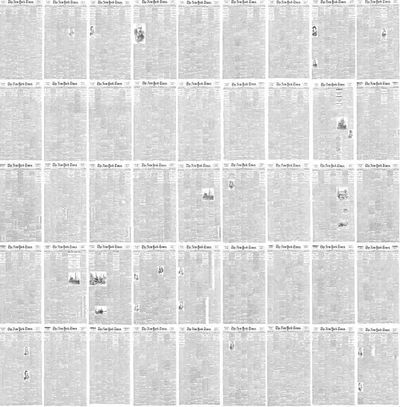
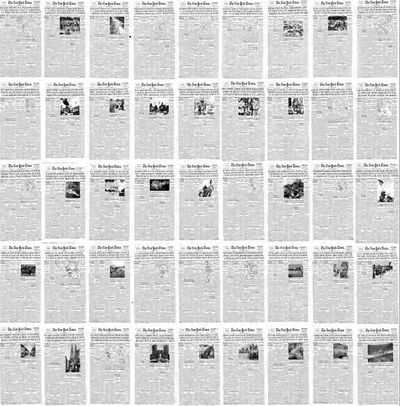
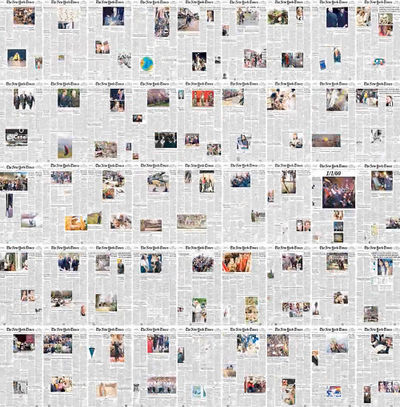
Icy and Sot
Responding to issues of border control and the refugee crisis, Iranian artist duo Icy and Sot (previously) created a variety of fence and border interventions. The Brooklyn-based brothers most recently installed a piece outside The Lot Radio in New York, and exhibited several new artworks with Thinkspace Art Gallery for a show titled Human (Nature).
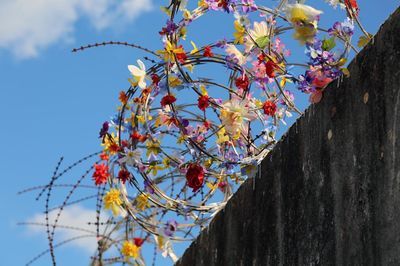
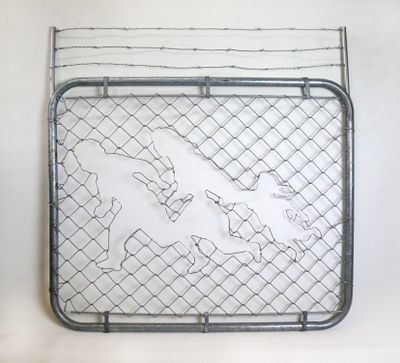
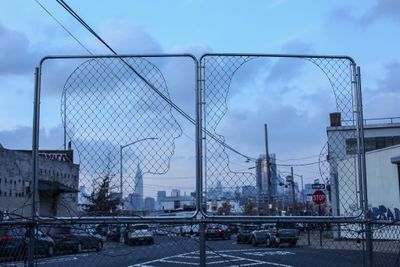
J.frede
Artist j.frede composes flea market photographs into custom built frames, creating visual and narrative landscapes from the previously unassociated materials. The works spread across the wall, building on each other through similar landscapes or horizon lines. The project, titled Fiction Landscapes, builds on the artist’s interest in memory, tapping into others’ momentos of the past to create fictionalized scenes of ambiguous origin.
Although each image has once been a placeholder in time for the photographer, once it gets collected into a mixed up bin at a flea market these associations are erased. “Arranging these into new landscapes that have never existed speaks to the stitching together of human behavior and how we relate to time and the past,” says Frede. “How many people have pulled over at that rest stop and taken nearly the same photo of the plain hillside? All locking their own associations into the view, first road trip with a new love; last road trip to see grandma; one of many road trips alone.”
The Los Angeles-based artist strictly uses anonymous photographs from the past for his works, never incorporating photographs of his own or individuals he knows. The memories he personally imbues into each composition in the series are instead ones he creates while making each arrangement, placing his own marker within the newly composed environment.
ugur gallen
Hi, I'm Uğur.
I live in Turkey, which happens to be located next door to one of the most dangerous regions in the modern world. The contrast between these territories reflects two different worlds for me, and it inspired me to portray this in my work.
Some of my work was previously featured on Bored Panda and I would like to share my new pieces.
I wish a peaceful future.
EUROPE’S MIGRANT TRAIL, THROUGH THE INSTAGRAMS OF REFUGEES
Before the summer of 2015, the island of Lesvos was a quiet place, known by classicists for the poetry of Sappho, who lived there in the sixth century B.C.; by tourists for its beaches and rolling pine forests; and by Greeks for its salted sardines. The occasional boatload of refugees arrived on its shore from neighboring Turkey. Then, with wars in Iraq, Syria, and Afghanistan intensifying alongside other crises—drought, repression, terrorism—in Africa and Asia, more than a million people fled to Europe, and many of them to Lesvos. Suddenly, the news was inundated with images of refugees and migrants in hijabs, praying to Mecca, corralled behind barbed-wire fences, and Lesvos became a glyph for hardship in the modern world.
The photojournalists who documented the suffering of these refugees began their projects along traditional lines. Some of them, from the Times and from Reuters, won Pulitzer Prizes for images explicitly showing the dangers and humiliations people have endured in their search for a better life in Europe. As the crisis continued last year, the Belgian photographer Tomas van Houtryve embarked on a different kind of project. Supported by a grant from the Pulitzer Center on Crisis Reporting, he followed the “digital breadcrumbs” left by refugees on social media as they passed through Turkey, Greece, and France. Van Houtryve, who has covered wars in Nepal and Afghanistan as a traditional photojournalist, became interested in the ways in which digital technology affects photography when, in 2013, he began working on a series of photographs of the United States taken from drones. For his current project, which he has called “Traces of Exile,” he shot video footage of sites along the migrant trail in Europe. Then, using an augmented-reality app called Layar, he overlaid his footage with screenshots of images posted by refugees on Instagram from those same sites.
In collecting these images, van Houtryve discovered that many refugees emphasized not the suffering of their journey but moments that were joyous, triumphant, and even amusing. From Turkey’s city of Izmir, where many refugees begin their dangerous treks, the Instagram user reza.hdz posted a selfie of himself making a funny face with a group of friends; another user, iq.y7, posed with a friend flexing his arm for the camera upon arriving in Athens’s port, Piraeus; in Idomeni, in northern Greece, user 3bdulk7der.krayem took a photo with his youngest brother Ayham, both wearing huge grins despite the fact that they had become stuck there after the former Yugoslav Republic of Macedonia closed its border a few weeks beforehand. In its highlighting of the idiosyncratic and personal side of the migrant experience, the resulting collection, “Traces of Exile,” recalls work by photographers such as Jim Lommasson, whose continuing, and very moving, “What We Carried” project showcases images and objects Iraqi and Syrian refugees brought with them as they fled their countries—wedding pictures, diaries, the glasses of a beloved relative—alongside captions written by the refugees themselves. But van Houtryve’s project, unlike Lommasson’s, is not about memory and longing for a homeland but about how his subjects, most of them young men, choose to present themselves to their friends and families. As van Houtryve puts it, the smartphone “is their mirror that they hold up to the world,” as well as their way to communicate that they are safe to people back home who may be worried.
Guy Debord
La Société du spectacle van Guy Debord (1931-1994), oorspronkelijk gepubliceerd in 1967, heeft niets aan relevantie ingeboet, want de geschiedenis doet er alles aan om Debords analyses te bevestigen. Terwijl de spektakelmaatschappij, als extreme vorm van kapitalisme, zich uitbreidt over de hele planeet, bewijst de hedendaagse beeldinvasie dat het beeld-geworden kapitaal in ons bestaan een status van absolute oppermacht heeft bereikt. Wij zijn gereduceerd tot passieve beeldconsumenten, de permanente onderdompeling in een schijnwereld is onze echte wereld geworden.
In het werk, dat geschreven is als een reeks van 221 polemische stellingen, beschrijft Debord de westerse consumptiemaatschappij als beheerst door het "spektakel", niet te verwarren met het schouwspel van massamedia en reclame in engere zin. Het allesoverheersende spektakel is een nieuwe vorm van vervreemding die het door Marx gesignaleerde warenfetisjisme overstijgt, doordat het de overdreven nadruk op het "hebben", op het eigendom vervangt door het abstractere "verschijnen", op het imago. In de spektakelmaatschappij, schrijft Debord, is "de waarneembare wereld vervangen [...] door een keur van beelden die erboven staat," terwijl deze beelden worden gepresenteerd "als het waarneembare bij uitstek." Daarnaast bekritiseert Debord in het werk de sociaaldemocratie en het communisme, die beide de massa in de mal van vertegenwoordiging hebben gegoten. In plaats daarvan pleit Debord voor een radicale, directe democratie.
Debord maakte in 1973 ook een film met de titel La Société du spectacle, gebaseerd op de ideeën die hij in het boek uiteenzet.
Bellycat
Whoever Controls the Media, the Images, Controls the Culture | Min Kim | TEDxLehighU
they offer us things we know we will enjoy and shield us from looking at thinks that might make us use their platform less. They feeds in on our passions, our insecurities (fear? )our ego, and every facet of our complicated identity. in order for us to feel self righteous, comfortable and satisfied.
direct inexperience is the best experience that you can have. No tv or media that shows you the world but you who discovers them.
Henri Frankfort
Before Philosophy: The Intellectual Adventure of Ancient Man
Such a unified spirit was born of the sense of common peril. The common desire for security need not have survived after the Egyptian Empire extended the military frontier of Egypt well into Asia and thus removed the peril from the immediate frontier. That should have given the external security which would relieve the need for communal solidarity. However, it was a resdess age, and there were perils on the distant horizon which could he invoked to hold the community together, since unity was to the advantage of certain central powers. When the threat of the Hyksos had subsided, the threat of the Hittites appeared and endangered the Asiatic Empire of Egypt. There- after came the Sea Peoples, the Libyans, and the Assyrians. A fear psychosis, once engendered, remained present. And there were forces in Egypt which kept alive this fear psychosis in order to maintain the unified purpose of Egypt.
Edmund Burk
No passion so effectually robs the mind of all its powers of acting and reasoning as fear.
Plato
Imprisonment in the cave
Plato begins by having Socrates ask Glaucon to imagine a cave where people have been imprisoned from birth. These prisoners are chained so that their legs and necks are fixed, forcing them to gaze at the wall in front of them and not look around at the cave, each other, or themselves (514a–b).[3] Behind the prisoners is a fire, and between the fire and the prisoners is a raised walkway with a low wall, behind which people walk carrying objects or puppets "of men and other living things". The people walk behind the wall so their bodies do not cast shadows for the prisoners to see, but the objects they carry do ("just as puppet showmen have screens in front of them at which they work their puppets". The prisoners cannot see any of what is happening behind them, they are only able to see the shadows cast upon the cave wall in front of them. The sounds of the people talking echo off the walls, and the prisoners believe these sounds come from the shadows.
Socrates suggests that the shadows are reality for the prisoners because they have never seen anything else; they do not realize that what they see are shadows of objects in front of a fire, much less that these objects are inspired by real things outside the cave which they do not see.
Departure from the cave
Plato then supposes that one prisoner is freed. This prisoner would look around and see the fire. The light would hurt his eyes and make it difficult for him to see the objects casting the shadows. If he were told that what he is seeing is real instead of the other version of reality he sees on the wall, he would not believe it. In his pain, Plato continues, the freed prisoner would turn away and run back to what he is accustomed to (that is, the shadows of the carried objects). He writes "... it would hurt his eyes, and he would escape by turning away to the things which he was able to look at, and these he would believe to be clearer than what was being shown to him."
Plato continues: "Suppose... that someone should drag him... by force, up the rough ascent, the steep way up, and never stop until he could drag him out into the light of the sun."[3] The prisoner would be angry and in pain, and this would only worsen when the radiant light of the sun overwhelms his eyes and blinds him.
"Slowly, his eyes adjust to the light of the sun. First he can only see shadows. Gradually he can see the reflections of people and things in water and then later see the people and things themselves. Eventually, he is able to look at the stars and moon at night until finally he can look upon the sun itself (516a)."[3] Only after he can look straight at the sun "is he able to reason about it" and what it is (516b).[3] (See also Plato's Analogy of the Sun, which occurs near the end of The Republic, Book VI.[4][5])
Return to the cave
Plato continues, saying that the freed prisoner would think that the world outside the cave was superior to the world he experienced in the cave; "he would bless himself for the change, and pity [the other prisoners]" and would want to bring his fellow cave dwellers out of the cave and into the sunlight (516c).[3]
The returning prisoner, whose eyes have become accustomed to the sunlight, would be blind when he re-enters the cave, just as he was when he was first exposed to the sun (516e).[3] The prisoners, according to Plato, would infer from the returning man's blindness that the journey out of the cave had harmed him and that they should not undertake a similar journey. Plato concludes that the prisoners, if they were able, would therefore reach out and kill anyone who attempted to drag them out of the cave (517a).[3]
Symbolism[edit]
"Plato's Cave Allegory" by Markus Maurer
The allegory contains many forms of symbolism used to describe the illusions of the world. The cave represents the superficial world for the prisoners. The chains that prevent the prisoners from leaving the cave represent ignorance, meaning the chains are stopping them from learning the truth. The shadows that cast on the walls of the cave represent the superficial truth, which is an illusion that the prisoners see in the cave. The freed prisoner represents those in society who see the physical world for the illusion that it is. The sun that is glaring the eyes of the prisoners represents the real truth of the actual world
De correspondent
We zijn jouw medicijn tegen de waan van de dag
Nieuws gaat meestal over wat er vandaag gebeurt, maar zelden over wat er elke dag gebeurt. Het richt zich op de uitzonderingen, waardoor de regel buiten beschouwing blijft. De Correspondent heeft een andere opvatting van nieuws: wij kijken niet naar het sensationele, maar naar het fundamentele. Onze correspondenten laten zich niet leiden door de waan van de dag, maar richten hun aandacht op structurele ontwikkelingen in onze samenleving en in de wereld. Anders gezegd: wij vertellen je niet over het weer, maar over het klimaat – en hopen je zo dieper inzicht te geven in hoe de wereld werkt.
We zijn volledig advertentievrij
De Correspondent is een advertentievrij platform. Daaronder valt ook zogeheten gesponsorde content. We worden gefinancierd door betalende leden, die we niet als 'doelgroepen' zien. We verkopen jouw aandacht en jouw persoonlijke data niet door aan adverteerders. We staan wel open voor inhoudelijke samenwerkingen met andere media. Ook accepteren we financiering van organisaties wier investeringen direct bijdragen aan onze journalistieke doelen. Bij zulke financiering is één voorwaarde ononderhandelbaar: volledige redactionele onafhankelijkheid.
INSPIRATION LINKS
References:
[1]





